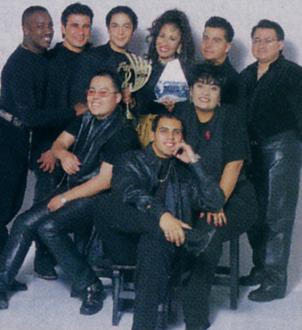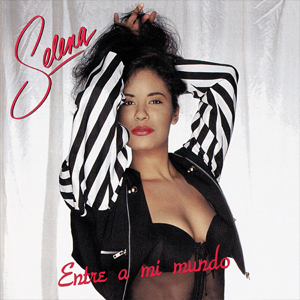
Christopher Gilbert Pérez is an American guitarist, best known as lead guitarist for the Tejano band Selena y Los Dinos. He married the frontwoman of the group, Selena, on April 2, 1992. Pérez grew up in San Antonio, Texas as one of two children of Gilbert Pérez and Carmen Medina. In 1986, he began his tenure by joining Shelly Lares' band. By the late 1980s, Pérez was respected among Tejano musicians for his guitar skills. This caught A.B. Quintanilla's attention; at the time, A.B. was seeking another guitarist for the band he produced, Selena y Los Dinos. Between one and two years after Pérez joined the band, he and Selena began a personal relationship.

Selena y Los Dinos was an American Tejano band formed in 1981 by Tejano singer Selena and her father Abraham Quintanilla. The band remained together until the murder of Selena in 1995, which caused the dissolution of the band in the same year. When Selena was signed with EMI Latin, EMI president José Behar told Selena that "the world wanted Selena, not Selena y Los Dinos." Selena then began releasing her solo studio albums under her name and her own logo title Selena instead of Selena y Los Dinos. Before Selena was signed with EMI, the band had sold more than 80,000 copies in the state of Texas.

Ven Conmigo is the second studio album by American singer Selena, released on November 12, 1990, by EMI Latin. The singer's brother, A.B. Quintanilla III remained her principal record producer and songwriter after her debut album's moderate success. Selena's Los Dinos band composed and arranged seven of the album's ten tracks; local songwriter Johnny Herrera also provided songs for Selena to record. Ven Conmigo contains half cumbias and half rancheras, though the album includes other genres. Its musical compositions are varied and demonstrate an evolving maturity in Selena's basic Tejano sound. The album's structure and track organization were unconventional compared with other Tejano music albums. The songs on Ven Conmigo are mostly love songs or songs following a woman's struggles after many failed relationships.

Entre a Mi Mundo is the third studio album by American singer Selena, released on May 6, 1992, by EMI Latin. The label endeavored to bolster Selena's popularity within the Latin music market in the United States with this release. Selena's brother, A. B. Quintanilla sustained his role as the singer's producer and, in collaboration with Selena y Los Dinos members Pete Astudillo and Ricky Vela, composed tracks for the album. The ensuing recording encompassed an eclectic array of songs, attributable to the members' diverse backgrounds, which facilitated the modernization of the sundry genres they explored. Entre a Mi Mundo is a Tejano cumbia album that encapsulated Selena's quintessential sound, characterized by engaging tunes harmonized with her distinctive, plaintive vocals and a relaxed, danceable cumbia beat. The album incorporates musical inspirations from power pop, R&B, disco, rock, funk, and synthesized Tejano music.

Selena is the self-titled debut studio album by American Tejano singer Selena, released on October 17, 1989, by EMI Latin. Its music incorporates a range of contemporary genres with a mix of cumbia and regional styles of Mexican music. The album was released following company president Jose Behar's failed crossover request for the singer. The project was denied by the heads of EMI Records' pop division, believing the singer should first strengthen her fanbase. Selena's brother and principal record producer and songwriter, A.B. Quintanilla III fought to remain the singer's producer. The band introduced Pete Astudillo and Joe Ojeda, who contributed to the album's experimental production and songwriting. Aside from A.B., Selena worked with two Mexican songwriters, Alejandro Montealegre and Reinaldo Ornelas.

Live! or Selena Live! is a live album by American Tejano pop singer Selena, which was released on May 4, 1993, by EMI Latin. The album was re-released on September 22, 2002, as being part of the Selena: 20 Years of Music collection; which included spoken liner notes by her family, friends and her former band members Selena y Los Dinos. Live! includes three cumbia-influenced studio tracks, while the rest of the album consists of live versions of previously released songs. The album was recorded during a free concert at the Memorial Coliseum in Corpus Christi, Texas, on February 7, 1993. It was certified gold by the Recording Industry Association of America in its first year, double platinum in 1995, and 8× platinum in 2017.

Momentos Intimos is a compilation album by American singer Selena and released posthumously on March 23, 2004, through EMI Latin. The album contains 24 tracks, though the last eight are spoken liner notes provided by the singer's family, friends, and her Los Dinos band. The songs on the album range from "Como Te Quiero Yo A Ti" (1988), a re-recorded version modernized and remixed on the album, to "Puede Ser", an unreleased duet with Nando "Guero" Dominguez, recorded two weeks before Selena was shot and killed in March 1995. Following Selena's death, her father Abraham Quintanilla expressed his interest in persevering his daughter's memory through her works. Selena's family has been criticized by fans and the media for exploiting the singer and cannibalizing her murder by commercializing her repertoire.

"Ámame" is a song by American singer Selena, taken from her third studio album, Entre a Mi Mundo (1992). Selena and Chris Pérez began secretly dating subsequent to Pérez's reintegration into Selena y Los Dinos in the summer of 1991, despite her father's objections. The song was written by Selena and conveys her sentiments towards Pérez as they concealed their liaison from familial scrutiny. Pete Astudillo contributed to the lyrical development of the composition, while A. B. Quintanilla handled production. It was released as the fourth and final single from the album in April 1993.
"Dame Un Beso" is a 1986 song by Mexican-American singer Selena, from her third album, Alpha. It was recorded when she was 14 years old. The song was written by A. B. Quintanilla and Ricky Vela, who were both in her band at the time. A. B. Quintanilla, Selena's brother, had grown tired of the more old-fashioned songs that his father would choose and write, and decided to take over and write almost all of her songs.
"Dame Tu Amor" is a song recorded by American recording artist Selena for her second LP record, Alpha (1986). Lyrically, the narrator addresses her infatuation to give her his love as she is longing for him to do so with a kiss that ensures admiration for her. The themes explored in the song suggest solicit love. "Dame Tu Amor" is a ranchera ballad with cumbia influences. It was composed by Richard Brooks, Ricky Vela, and Selena's father and manager, Abraham Quintanilla, Jr. Critics praised the song for its instrumentation and lyrical content and has since been in several compilation albums following Selena's death in 1995. "Dame Tu Amor" peaked at number 31 on the US Billboard Hot Ringtones chart in 2006.
"Besitos" is a song recorded by American singer Selena on her eponymous debut album with EMI Latin. It was composed by A. B. Quintanilla and Pete Astudillo. Upon signing a recording contract with EMI Latin, A. B. was cautioned that failure to produce a successful album would result in his replacement by a company-approved candidate. The group Los Bad Boyz, composed of Astudillo and keyboardist Joe Ojeda, initially opened for Selena y Los Dinos before integrating themselves into the band's lineup. Astudillo's songwriting debut came in the form of "Besitos", a composition in which the lyrics convey a longing for the protagonist's lover's kisses and a desire to be their source of happiness.

Abraham Isaac Quintanilla Jr. is an American singer, songwriter, and producer. He is the father of Tejano singer Selena and was her manager throughout her life.

Dulce Amor is the sixth and last independent studio album by Tejano music group Selena y Los Dinos. The album became the final album to be released from RP Records on December 24, 1988. Selena's brother, A.B. Quintanilla III had become the main songwriter. Selena recorded fourteen songs but only released ten. All the songs were recorded in three different recording studios. Dulce Amor helped Selena to be noticed at the 1989 Tejano Music Awards. She was then signed by EMI Latin. This would be the last studio album to be released under “Selena y Los Dinos” as all subsequent albums would be released under “Selena”. The album had only sold over 30,000 copies. It was ordered to be removed from stores by EMI Records.

And the Winner Is... is the fourth independent studio album by Tejano music group Selena y Los Dinos. It was released in April 1987 under Manny Guerra's GP Productions. The title alludes to the multitude of accolades Selena garnered since her entry into the music industry. And the Winner Is... was unveiled with the objective of expanding the Tejano audience that the band had recently enthralled. Among the album's singles, "La Bamba" represented Selena's initial appearance on a national music chart, reaching its peak at number 20 on the US Billboard Hot Latin Tracks chart in August 1987. Concurrently, Selena's rendition was released around the same time as Los Lobos', which supported the eponymous film. As Selena y Los Dinos was a relatively obscure group, their version began to wane on the chart as Los Lobos' version climbed. And the Winner Is... garnered favorable reception from music critics, with Tim Baker of Newsweek observing the group's gradual elimination of their characteristic doo-wop sound from prior recordings. While And the Winner Is... secured a nomination for Album of the Year at the 1988 Tejano Music Awards, Selena won Female Vocalist of the Year, her second consecutive win.

16 Super Exitos Originales is a greatest hits album by American singer Selena released on March 3, 1990, through EMI Latin. The label aimed to release a compilation containing recordings by Selena y Los Dinos prior to their contractual agreement in 1989, to illustrate the band's musical progressions up to that point. 16 Super Exitos Originales encompasses 16 tracks re-recorded under new arrangements, ranging from compositions recorded through Freddie Records in 1983 to the group's Dulce Amor (1988) album. The album received critical acclaim from music critics, who found it to have contained recordings that solidified Selena's status in the Tejano music market and introduced her to a broader audience. The album peaked at number 22 on the US Billboard Regional Mexican Albums chart. EMI Latin posthumously re-issued 16 Super Exitos Originales under the title Mis Primeros Exitos on August 13, 2002.

Muñequito de Trapo is the third independent studio album by Tejano music group Selena y Los Dinos. It was released in 1986 under Manny Guerra's GP Productions. The album was originally intended to be an LP for DJ Promotional use only; however, it was later released on cassette. The album mostly consists of cover songs with very little original material. Tim Baker of Newsweek called the album "A return to the 'oldies-rock & roll' sound of the first album."

Preciosa is the fifth independent studio album by Tejano music group Selena y Los Dinos. It was released on October 10, 1988 under Manny Guerra’s RP Records. Preciosa garnered favorable reception from music critics, with Tim Baker of Newsweek observing the group finally purging their oldie influences from their discography. At the 1989 Tejano music awards, Selena was the finalist for Female Vocalist of the Year. Terco Corazon was nominated for Single of the Year, and A.B was nominated for Songwriter of the Year.

Selena y Los Dinos is the debut independent studio album by American Tejano music group Selena y Los Dinos. It was released on July 16, 1984 under Freddie Martinez’s Freddie Records. The album was originally released in cassette format and in limited quantities. The album was not sold in stores and Freddie records did little to promote it. In 1995, the album was re-issued under the title Mis Primeras Grabaciones and again in 2005, during the 10th anniversary of Selena's passing, with remastered audio tracks.















